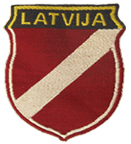15th Waffen Grenadier Division of the SS (1st Latvian)
Contributors to Wikimedia projects
 Article Images
Article Images
The 15th Waffen-Grenadierdivision der SS (lett. Nr. 1) was formed in the Waffen SS's drive for manpower in the wake of Operation Barbarossa, Nazi Germany's invasion of the Soviet Union in June 1941. After a successful recruitment drive in the Reichskommissariat Ostland (Baltic states) for the Nazi anti-partisan brigades, Heinrich Himmler formed Baltic legions by late August 1942, including the Lettische SS-Freiwilligen-Legion, the nucleus of the later 15th Waffen Grenadier Division of the SS.
| 15th Waffen Grenadier Division of the SS (1st Latvian) | |
|---|---|
 Insignia of 15th Waffen Grenadier Division of the SS (1st Latvian) | |
| Active | 1943 - 1945 |
| Country | |
| Branch | |
| Size | Division |
| Part of | VI SS Volunteer Army Corps (Latvian) |
| Insignia | |
| Identification symbol |  |
| Identification symbol | Latvian legionnaires Armshield |
However the small scale of these Legions were inadequate for widespread Russia and soon merged into divisions with the Lettische SS-Freiwilligen-Legion renamed as the SS-Freiwilligen-Division, with the numerical designation of 15 soon added. To bolster the numbers, Himmler enforced compulsory military service in the Ostland in age groups 1915-24 in 1943 then 1904-14 and 1925-26 in 1944. These Latvian conscripts would form the renamed 15th Waffen-Grenadier-Division of the SS (note 'Voluntary' title dropped) in time for the Soviet attack of 1944. The 15th SS was swept up in the chaos of the collapse of the Eastern Front and lost much of its spirit after the Soviet re-occupation of their homelands. It was soon trapped and decimated in their hopeless defence of Pomerania.
The Division fought on the Pomeranian Wall defences. At Podgaje, 2 February 1945, men of that division performed a war crime on Polish prisoners of war, burning in a barn 32 soldiers from 4th company, 3rd regiment infantry 1st Division Polish First Army tied up with a barbed wire.[1][2][3]
However out of fear of Russian revenge it fought well in the last months of the war, with a surviving battalion in the last defence of Berlin in mid-1945. Other remnants under Waffen-Standartenführer Vilis Janums surrendered to the advancing Americans at Güterglück near the Elbe River.

Commanders
- SS-Brigadeführer und Generalmajor Peter Hansen (February 25, 1943 - May 1, 1943)
- SS-Gruppenführer und Generalmajor Carl Graf von Pückler-Burghauss (May 1, 1943 - February 17, 1944)
- SS-Oberführer Nikolaus Heilmann (February 17, 1944 - July 21, 1944)
- SS-Oberführer Herbert von Obwurzer (July 21, 1944 - January 26, 1945)
- SS-Oberführer Dr. Eduard Deisenhofer (January 26, 1945)
- SS-Oberführer Adolf Ax (January 26, 1945 - February 15, 1945)
- SS-Oberführer, later Brigadeführer und Generalmajor Karl Burk (February 15, - May 2, 1945) [4]
Order of battle
- Waffen Grenadier Regiment of SS 32
- Waffen Grenadier Regiment of SS 33
- Waffen Grenadier Regiment of SS 34
- Waffen Artillery Regiment of SS 15
- Waffen Füsilier Battalion of SS 15
- Waffen Flak Battalion of SS 15
- Waffen Signals Battalion of SS 15
- Waffen Pionier Battalion of SS 15
- Waffen Panzerjäger Battalion of SS 15
- SS Medical Battalion 15
- SS Nachschub Troop 15
- SS Feldpost Department 15
- SS Veterinary Company 15
- SS Wirtschafts Battalion 15
- SS Bau Regiment 1 of 15. SS-Division
- SS Bau Regiment 2 of 15. SS-Division
- SS Feldersatz Battalion 15
- SS Waffen Feldgendarmerie Troop 15
- SS War Reporter Troop 15 [5]
References
- ^ Majewski, Ryszard: Waffen SS. Mity i rzeczywistość. , Wrocław : Krajowa Agencja Wydawnicza, 1983, s. 247, ISBN 83-0300-102-7
- ^ Polski czyn zbrojny w II wojnie światowej., Warszawa : Wydawnictwo Ministerstwa Obrony Narodowej, 1988, s.531 (tom 3), ISBN 83-1107-038-5
- ^ Ważniejsze bitwy na Wale Pomorskim podczas II wojny światowej
- ^ Rickmenspoel,M. Waffen-SS Encyclopedia. Aberjona Press, 2004.
- ^ Wendal, Marcus. "15. Waffen-Grenadier-Division der SS (lettische Nr. 1)". Axis History. Archived from the original on 2009-05-02. Retrieved 2009-03-15.
- Stein, G (1966) The Waffen SS: Hitler's Elite Guard at War 1939-1945. Cornel Uni. Press, London.